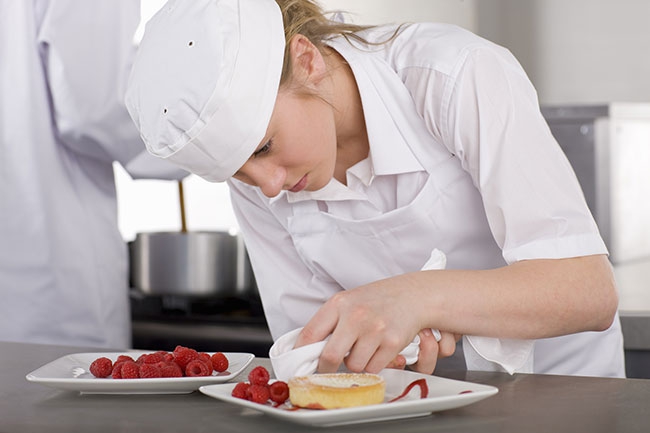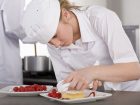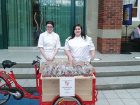
The Next Generation
May 1, 2015
By Carolyn Camilleri
Baking-school instructors talk trends and about how students are influencing the industry
 Culinary arts instructors say they are seeing an increase in entrepreneurial aspirations among their students these days. Photo: Fotolia
Culinary arts instructors say they are seeing an increase in entrepreneurial aspirations among their students these days. Photo: FotoliaTo borrow from Bob Dylan, the times they are a-changing, and nowhere is that more evident than in the baking and pastry programs across the country. And the students are changing, too.
The Culture
“The culture has changed over even the last five years,” says Alan Dobko, an instructor at Vancouver Community College. “The awareness has gotten better, people have gotten more savvy.”
Clarke Adams, an instructor at Calgary’s SAIT Polytechnic, says students are entering the program with more food education than in the past.
“There is a far greater awareness of where ingredients are coming from: they want to know if the flour is from Alberta. They want to know where the chocolate is from,” Adams says. “I had a student last week who asked me if the chocolate is fair trade.”
Of course, the Food Network and the food-awareness trend have naturally influenced students – but so have other factors.
“Technology and how they view the industry is really shaped by Internet and having access to information instantaneously,” says Clayton Folkers, an instructor at NAIT Polytechnic in Edmonton. “They have grown up with that and that is their expectation – you can go anywhere anytime and look up anything that you want.”
Tony Bond, program coordinator at Algonquin College in Ottawa, talks about how printing on marshmallow paper – which used to be state of the art – is now old hat. The current marvel, for him, is 3D printers for chocolate and sugar.
“It is a little like Star Trek, really,” Bond jokes, but adds that students are largely unphased by it all, having grown up with technology.
What it all comes down to is that students today have a different definition of normal. Answers are a click away and technology does change with breakneck speed – and choosing a food career means being food aware.
The Products
“From an industry perspective, the trends are definitely natural products, traceability, local, organic where possible, and seasonal,” says Christophe Measson, a professor of baking and pastry arts at George Brown College in Toronto.
So significant is this change in thinking, that six or seven years ago, the entire curriculum at George Brown was changed to line up with trends and meet the expectations of students. Measson says the previous curriculum, while strong from a skills perspective, lacked in ingredient integrity.
“We were teaching students to make choux pastry for an éclair and when I looked at the ingredients, there was not a single natural ingredient in any of the recipes,” Measson says.
Quick-method bread using shortening was also eliminated from the curriculum.
“Now, we make a more artisan bread, with natural starters, which give all these nice flavour profiles,” says Measson, adding that he isn’t saying that less natural products should be banned, because they still need to introduce students to mass production, but rather that the fundamental skills should be taught using natural ingredients.
“It is much more important for them to know how to make the real thing,” he says.
Confectionery has also changed.
“The big trend in confectionery is caramels, fruit pastes, licorice – old-fashioned candies made in-house with natural fruit purées and natural sugar and real gelatins like pectin – beautifully made and packaged,” Measson says.
Using natural ingredients also means a change in how products are evaluated.
“We are really pushing flavour to the forefront of everything that the students are learning and doing, rather than it just being pretty or made properly, and although that is important, it is not the sole value in the product any longer,” says Amede Lamarche, a professor of baking and pastry arts at George Brown College.
And the students like it.
“It has been a really remarkable process and the students have responded exceptionally well to it,” Lamarche says.
Something else students like is innovative flavours and textures.
“What I have noticed with my students is that I am getting a number of them that are coming through the culinary program and they are really interested in layering flavours in baking,” Dobko says. “They want to incorporate some savouriness into the sweet, giving it a greater multitude of levels when you bite into it.”
As examples, Dobko and his colleague Nancy McRae list chocolate blended with cumin, mint, matcha, and chili peppers, as well as lavender, orange, lemon and lime oils.
Students are also inclined to use less sugar.
“It is a combination of two things: definitely an awareness of healthier lifestyle and nutrition values, and also I would say a definite change in taste,” Measson says. “People now want more to taste the product rather than the sugar.”
Sugar is treated more like a seasoning, and it is being applied to classic recipes – new versions of older recipes, with less sugar and a new look.
Techniques like Craquelin – a very thin layer of sweet dough applied over choux pastries to control rise and the finished esthetic—are other examples of innovation in the classroom.
“Little innovations like that have both improved the quality of the product and improved the process along the way,” Lamarche says. “And that can’t be a bad thing.”
Career Plans
A few years back, everyone was just looking to get a job, Adams says. No one was looking to be their own boss.
“Now, there is a lot more entrepreneurial spirit,” he says. “We give a survey to all the incoming students – ‘What do you want to do with this course when you are done?’ – and over 80 per cent of them say they want to own their own business, whether it is a wedding cake business or a food truck or anything and everything in between.”
While Adams says they still get people who want to “work for Fairmont and travel the world,” the new entrepreneurs are focused on small businesses that service their neighbourhoods.
And they know what they want to make.
“They have three or four pillar items that they have in mind,” Adams says. “They are looking to create their own niche or do a twist on something they have seen or experienced.”
Bond says that while the cupcake trend is passing over, the niche concept that it created has remained. Like Adams, he sees students focusing on niche businesses, with some working from home and some renting space within other bakeries, then shipping product out to hotels and restaurants.
Then there is the food truck craze, where grab-and-go portions are served with coffee.
“I have one student who already has the truck sitting at home in her garage waiting to go,” Adams says.
Even financing these new ventures has been given a twist.
“Some of our former students started their own business using crowd-funding and Kickstarter,” Folkers says.
To survive, these entrepreneurial bakers have recognized the need to make above-average products.
“Nobody can open a bakery and make an average product, because there is too much out there,” Measson says. “There is becoming a clearer distinction between natural products and mass-produced products.”
Enter authenticity.
The Real Thing
“People are demanding authenticity more and more – I see it in Toronto but I think it is true to Canada in general,” Measson says. “More places are doing authentic croissant or baguette. That is the level of pastry that people are producing now. And this is very much the direction students are going.”
Authenticity comes with a price – one more people are willing to pay, Lamarche says.
Martin Barnett, BAC director and program chair at Vancouver Island University, concurs.
“A loaf of bread can be seven, eight, nine dollars. But people are willing to pay for decent baked goods.”
Which takes us back to the classroom where students learn to make authentic products that warrant prices that can support niche businesses.
“As instructors, we are not going to teach people how to take things out of boxes and how to use mixes – that’s not the trade – the trade is scratch baking and we are going to teach people how to work, obviously, and be professional,” Barnett says. “We teach that there is institutional baking out there, but institutional baking is not driving education, not like it was 20 or 30 years ago,” referring to when grocery stores had scratch bakeries in-store.
Folkers believes part of his role as an instructor is to introduce students to different areas of the industry – areas they may not have considered. In other words, helping them find their niche.
“We try to give them a smattering of everything and say, ‘Here are some of the possibilities,’” says Folkers, explaining that a student may start out wanting to decorate cakes but then discover they want to work in chocolate.
McRae says students are wary about low pay rates and are opting for work at businesses where the owners are other pastry chefs who share their values.
Entering competitions is another way McRae and Dobko encourage students to distinguish themselves and make valuable connections.
“It has been helpful for us to bring it back into the curriculum. The networking has been just incredible,” Dobko says.
Emphasis on independent business has created a greater need to teach business skills such as lease negotiation and equipment sourcing.
“We have a big business component to the course now,” Adams says. “It is a whole different set of skills.”
And students need those skills.
“Twenty years ago, if you worked your butt off and made a good product, you survived,” Bond says. “Nowadays, you have to have a good business head, as well as make a good product to survive.”
Conclusion
About the future, instructors are generally optimistic – but they also preach the necessity of hard work and perseverance.
“There are great careers out there for bakers and pastry chefs that want to work,” Barnett says.
And despite challenges, students are finding ways to align their careers with their own beliefs and their generation’s expectations about where the industry should be headed.
Print this page



Leave a Reply